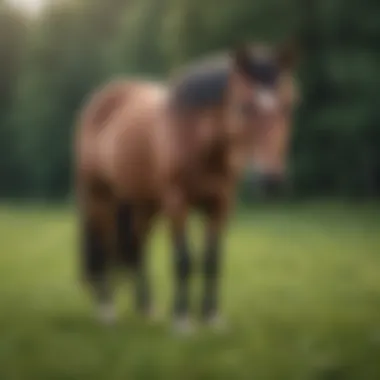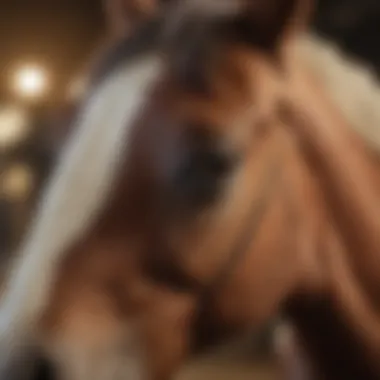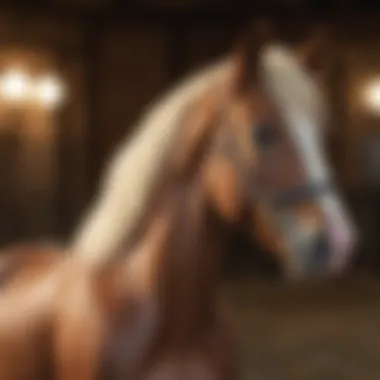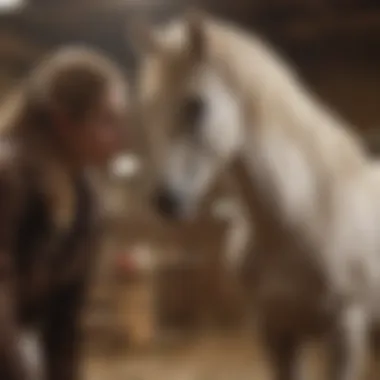Understanding the Costs of Miniature Horses


Intro
Miniature horses have carved a niche for themselves, captivating the hearts of many with their sturdy builds and gentle temperaments. With their playful antics and charming personalities, they can be a delightful addition to any home. However, before diving headfirst into ownership, it’s critical to grasp the financial landscape surrounding these pint-sized equines. From the initial purchase to ongoing care, potential owners need to navigate various factors that influence their overall investment.
This guide aims to illuminate the path to owning a miniature horse by offering insights into every facet of the pricing game. By the end, future horse owners should have a well-rounded comprehension of their financial commitment, plus a clear picture of the joy a miniature horse can bring, despite the realities of pet ownership.
Intro to Miniature Horses
Miniature horses, often seen as enchanting companions, have carved a niche for themselves in the vast world of equines. Their small stature, combined with an endearing disposition, makes them increasingly popular among pet lovers and hobbyists alike. As we delve into the topic, it’s crucial to grasp the essence of these remarkable creatures and the multifaceted aspects that may influence their price.
Understanding miniature horses goes beyond their size; it opens up a treasure trove of considerations for potential owners. These horses are not just pets; they are a commitment that requires careful thought and planning. When contemplating ownership, it’s vital to weigh the benefits, like companionship and joy they can bring, against the responsibilities and financial implications.
Why Gentle Giants Matter
Owning a miniature horse isn't merely about having a cute addition to your home. It provokes a sense of responsibility and attention to animal care, which includes everything from climate needs to dietary considerations.
As we navigate through the sections in this article, we aim to illuminate:
- The historical context that shaped the breed.
- The factors that influence their pricing, including lineage, training, and physical characteristics.
- An overview of both initial and ongoing costs associated with their care.
The journey through this guide is not merely about numbers. It’s an invitation to acknowledge the intrinsic value of these animals. As we peel back the layers on what it means to own a miniature horse, the discussions will equip prospective buyers with critical insights for making informed choices.
"Knowledge is the path to liberation, especially when investing in a life-long partnership with a miniature horse."
Understanding these dynamics not only enriches the decision-making process but lays down the foundation for a rewarding experience with these gentle beasts.
Defining Miniature Horses
A miniature horse is broadly characterized by its petite stature—typically standing no taller than 34 inches at the withers. However, height isn’t the only defining metric. Their temperament, adaptability, and the special relationships they foster with humans are what truly set them apart from their larger counterparts.
These horses are bred specifically to retain their small size while maintaining a harmonious proportionate body. Within this category, various breeds exist, such as the American Miniature Horse and the Falconer Miniature Horse, each with its own unique traits and characteristics.
Their lively nature and intelligence can match the more prominent horse breeds, demonstrating remarkable skills in agility and even therapy work. Hence, it’s not just their size that defines them, but also their personality and inherent qualities.
History and Purpose
The lineage of miniature horses can be traced back centuries, with origins in Europe, particularly among the smaller breeds of draft horses. These compact equines were often bred for practical purposes—primarily aiding in agricultural endeavors and serving as companions.
In the early 20th century, these tiny horses began to gain popularity as both work animals and pets. Communities recognized their utility, not only in farm tasks but also as gentle and engaging companions for families. Over time, their utility has evolved, leading to diverse roles in therapy and education.
Their purpose today can vary tremendously. Some owners appreciate their playful nature in family environments, while others might utilize them for therapeutic riding programs. The versatility of miniature horses elevates their appeal, making it vital to understand the myriad of roles they can fulfill in today's society.
Factors Affecting the Price of Miniature Horses
Understanding the price of miniature horses is a multi-faceted endeavor. It’s not just about exchanging money for a cute animal; it’s about recognizing the nuances that dictate their market value. Various factors contribute to the price, each playing a role in how much an owner will ultimately spend. For anyone considering adding a miniature horse to their family, understanding these factors can not only help with budgeting but also in selecting the right horse for their needs and lifestyle.
Breeder Reputation
A significant factor impacting the price of miniature horses is the reputation of the breeder. A well-regarded breeder often commands higher prices for their horses. This reputation is built on various criteria, like the quality of their animals, their breeding practices, and the health and temperament of the horses produced.
- Quality Assurance: Breeders who are known for their ethical practices and attention to detail instill confidence in potential buyers. They provide guarantees that the horses are free from genetic disorders and communicate transparently about the horse's history.
- Proven Results: If a breeder has history of consistently producing champions or well-tempered horses, buyers willing to invest will feel reassured, often leading to a willingness to pay a premium.
Bloodline and Pedigree
Another crucial determinant in the price of a miniature horse is its bloodline and pedigree. Horses that come from a lineage of show winners or notable performance animals can be far more expensive. Bloodlines can be traced back several generations, showcasing a history of excellence in characteristics valued by buyers.
- Valuable Traits: Traits such as conformation, temperament, and performance ability can be inherited; hence, bloodlines boasting these attributes are particularly sought after.
- Market Demand: The more prestigious the lineage, the more likely it is that people are willing to shell out significant sums for a horse that carries that name.
Age and Training Level


Age and level of training significantly affect pricing as well. A young, untrained miniature horse might command a lower price than an older horse that’s been trained for specific activities.
- Young Horses: Many buyers may find younger horses appealing for the potential they represent. However, they might require more time and resources to train, which can lead to additional expenses down the line.
- Trained Horses: Conversely, a horse that is already trained for driving, showing, or companionship can imply an instant return on investment for buyers, contributing to a higher upfront cost.
Physical Attributes
Physical attributes can also greatly sway prices. Buyers often look for specific traits in miniature horses that may enhance their desirability.
Coat Color
Coat color, while it might seem like a superficial characteristic, actually has financial implications within the market. Some colors, such as palomino or appaloosa, are often considered more attractive, leading to higher demand.
- Popularity and Trends: Colors can fall in and out of fashion, affecting prices. A vibrant coat may appeal more to customers looking for a showpiece.
- Maintenance: Depending on the color, maintenance needs may vary slightly, making certain colors more favorable to prospective owners.
Size and Conformation
Size and conformation are crucial in determining how well a miniature horse fits into its intended role.
- Functional Quality: Ideally, buyers look for horses that are not only visually appealing but also conform to breed standards. This is especially true for those interested in showing.
- Overall Health: The correct structure contributes to a horse's overall health and longevity, affecting not only its initial price but also future healthcare costs.
"When it comes to miniature horses, know that what meets the eye might just be the tip of the iceberg. Look deeper into these factors to truly understand the price you'll pay and the joy you'll gain."
Initial Costs of Purchasing a Miniature Horse
When you are thinking about getting a miniature horse, understanding the initial costs is crucial. Not only do these costs determine your upfront investment, but they also set the tone for your financial commitment as a horse owner. Unlike dogs or cats, which typically come with relatively low purchase prices, miniature horses can have a more considerable price tag. This cost comes from several factors, including their breed, age, and the seller’s reputation. Knowing these aspects can help you make a wise decision tailored to your budget and lifestyle.
Purchase Prices Across Breeds
The purchase price of a miniature horse varies widely depending on its breed. Some breeds are more common and readily available, while others are rarer and can fetch higher prices. For instance, the American Miniature Horse is quite popular and may generally cost between $800 and $2,500. In contrast, a Falabella, which is one of the smallest horse breeds in the world, could command prices starting at around $3,000 and reaching up to $10,000 due to its scarcity and lineage.
When considering the purchase price, factor in the following elements:
- Breed Popularity: More popular breeds may have a wider price range, while rarer breeds can carry premium price tags.
- Quality and Championship Pedigree: Horses that come from championship bloodlines or show-winning backgrounds will generally be more expensive.
- Age and Training: A well-trained, young miniature horse might cost significantly more than an untrained adult.
Understanding these factors can empower potential horse owners to negotiate better or identify the best fits for their needs.
Transport and Delivery Fees
Once you've settled on a miniature horse, the next financial consideration involves the logistics of getting it home. Transport fees can pack a punch, particularly if you’re buying from a breeder far away. The costs may include:
- Distance: Generally, the farther the distance, the higher the transport fees. Some services charge per mile, while others have set rates.
- Type of Transport: If you're hiring a specialized horse transport service, expect to pay more than if you’re using a standard trailer. The well-being of the horse during transit is paramount, so it’s crucial not to skimp on this aspect.
- Weather and Season: Prices can fluctuate based on demand; for example, transportation services might charge more in peak seasons such as spring when many people are purchasing horses.
It's vital to consider these costs in your overall budget before making a final decision on buying a miniature horse. A horse may be cute and small, but with the initial costs stacked up, the financial commitment can be larger than anticipated.
Always remember, investing in a horse goes beyond the purchase price. It's a continuous joy along with a financial commitment throughout their life.
Ongoing Costs of Ownership
Owning a miniature horse is not just a one-time expenditure; there are ongoing costs that need careful consideration. These expenses can accumulate and affect the overall economic commitment you make. Understanding these costs ensures potential owners are prepared and can manage their finances effectively.
Keeping in mind future costs allows owners to make lifestyle adjustments, setting aside budgets for food, medical care, grooming, and housing. The financial obligations are as real as a two-dollar bill when it comes to these charming creatures.
Feeding and Nutrition
Type of Feed
Feeding a miniature horse isn't just about tossing hay into a trough; it involves choosing the right type of feed that supports their unique nutritional needs. Nutritional balance is key, as these small equines still need vitamins, minerals, and energy.
One popular choice is hay specifically designed for small breeds. It's high in fiber, which is crucial for digestive health. However, not all hay is created equal. For instance, grass hay tends to be lower in calories compared to alfalfa hay. This difference can help with weight management, a significant consideration since miniature horses can easily pack on the pounds.


Advantages:
- High fiber content promotes good digestion
- Provides essential nutrients without excessive calories
Disadvantages:
- May require balancing with grains or supplements for optimal nutrition
Special Dietary Needs
Some miniature horses might have special dietary needs due to health conditions, age, or even weight issues. These considerations are absolutely vital and can dictate a feed plan tailored to individual requirements.
For instance, a miniature horse that’s prone to laminitis often benefits from low-sugar, low-starch feeds. Supplements that support joint health are also prevalent, especially in older horses. The ability to adjust the diet can greatly enhance their quality of life.
Key characteristic:
- Tailored feeding plans can prevent ailments and boost overall wellbeing
Advantages:
- Heavy focus on health can extend the life of the animal
- Customized feeds can help with specific issues, increasing owner satisfaction
Disadvantages:
- Higher cost and availability of specialized feeds might pose challenges
Veterinary Care
Routine Check-ups
Routine check-ups are essential in keeping your miniature horse healthy. Just like people, these small horses need regular visits to a vet.
Typically, owners can expect to pay for annual examinations, which involve checking overall health, performing dental evaluations, and monitoring weight. These visits can catch potential problems early, saving a lot of grief—and funds—in the long run.
Advantages:
- Early detection of issues can prevent more troubling health problems down the line
- Helps build a relationship with a trusted veterinarian, which plays a role in effective care
Disadvantages:
- Regular check-ups can add up, especially in the face of unexpected health issues
Vaccinations
Vaccinations are a cornerstone of good health for all horses, including miniature ones. Protecting them from diseases that can be detrimental to their well-being is non-negotiable.
Staying on top of a vaccination schedule can ward off some serious ailments. Moreover, it's often a requirement for participation in shows and events. Missing these can lead to catastrophic consequences for the horse's health and the owner's bank account.
Key characteristic:
- Effective vaccinations can save costs by preventing serious illness
Advantages:
- Significant reduction in the risk of widespread diseases
- Simplified participation in shows or events
Disadvantages:


- Vaccinations can be an upfront cost that fluctuates seasonally
Grooming and Maintenance
Caring for a miniature horse's physique is another key area of ongoing costs. Regular grooming, including brushing and hoof care, is necessary to keep your horse healthy and clean. The cost of grooming tools, as well as professional services if needed, can add up.
Shelter and Fencing Costs
Providing shelter and secure fencing for your miniature horse cannot be overlooked. The condition of their living space significantly impacts their quality of life. Whether constructing a barn or purchasing a shed, shelter can take a bite out of your budget. Similarly, good fencing ensures the safety of your beloved pet but can vary widely in cost depending on materials and installation choices.
In short, these ongoing costs of ownership are essential to consider before diving into buying a miniature horse. Each element plays a crucial role in ensuring the health and happiness of these little equine companions.
Market Trends and Pricing Dynamics
Understanding the market trends and pricing dynamics related to miniature horses is crucial for anyone considering purchasing one of these charming animals. The value of a miniature horse can be influenced by several factors, notably the cyclical nature of buying habits and economic fluctuations. Recognizing these trends enables potential buyers to make strategic decisions that align with their financial expectations and personal preferences.
Seasonal Pricing Variations
Prices for miniature horses can experience notable shifts throughout the year. For instance, spring and summer often see heightened demand as more people become interested in buying horses for outdoor activities. This seasonal surge can drive up prices, as sellers may capitalize on the increased interest. Conversely, during the fall and winter months, demand typically drops, leading to more competitive pricing. Buyers who are flexible about their timelines may find significant savings by purchasing during the off-season.
It is wise to track these seasonal trends closely, as they can create openings for savvy buyers to negotiate better deals.
Impact of Economic Factors
Supply and Demand
One cannot overlook the principle of supply and demand when discussing pricing dynamics. When there are a plethora of miniature horses available, often seen in spring when many foals are born, prices tend to stabilize or drop because buyers have plenty of choices. On the other hand, in times when fewer horses are on the market, a simple shift can push prices higher. This relationship is central to understanding the broader pricing landscape in miniature horse ownership.
The key characteristic of supply and demand is its responsiveness to local and global markets, influenced by breeding practices and the number of active sellers. A well-timed purchase during a buyer’s market can lead to substantial savings, making it an appealing option for many involved with these unique animals.
Broader Economic Conditions
The state of the broader economy also plays a significant role in pricing dynamics. When the economy is thriving, disposable income for potential owners tends to increase, which heightens demand for pets, including miniature horses. Conversely, during economic downturns, people might reconsider such investments.
One unique feature appearing in times of economic strain is increased attention to the quality of these horses rather than quantity, driving buyers to prioritize well-bred horses with compelling bloodlines, rather than simply looking for the lowest price. Here, the advantages are clear: buyers have the opportunity to acquire a horse that is likely to be a sound investment, while sellers may need to emphasize quality over quantity to maintain their sales.
Comparison with Standard Horses
When drawing comparisons between miniature horses and standard horses, buyers often find it easier to justify the investment in miniature horses due to their lower maintenance costs. While traditional horses may incur higher expenses related to feed, housing, and care, miniature horses can be a more accessible alternative for individuals who may not have the capacity for the larger commitments that standard horses require.
In summary, navigating the pricing landscape for miniature horses involves a careful examination of both seasonal trends and overarching economic factors. Whether an individual's passion lies in riding, companionship, or exhibition, understanding these elements can serve as a strategic advantage in making well-informed purchasing decisions.
Closure
In the journey of understanding the price of miniature horses, the conclusion serves as a crucial compass for prospective owners. It distills the information presented throughout the article, encapsulating the multifaceted considerations that can influence one’s financial commitment to these unique equines. As we've navigated through various sections—from factors that determine initial costs to the ongoing expenses associated with their care—it's evident that every element plays a role in shaping the overall financial landscape.
Summarizing the Financial Considerations
To sum it all up, miniature horses can be delightful companions, but they also come with a price tag that demands attention. Here are some key financial considerations:
- Initial Purchase Costs: Prices can vary widely based on breed, pedigree, and training, so be prepared for a range.
- Ongoing Care Costs: This includes feed, veterinary visits, and boarding expenses, which accumulate over time.
- Market Factors: The prices can fluctuate due to seasonal trends and broader economic conditions.
- Investment vs. Enjoyment: It’s essential to weigh the financial investment against the joy and companionship these animals bring.
While appreciating the financial aspects, it’s essential to remember that owning a miniature horse involves more than just the costs. It’s a commitment to their care and well-being, which can perhaps be seen as both a challenge and a rewarding experience.
Making Informed Decisions
Making an informed decision about bringing a miniature horse into your life is as vital as understanding the associated costs. Here are some considerations to keep in mind:
- Research Thoroughly: Get to know the specific breed you are interested in and gather insights from experienced owners or local breeders.
- Assess Your Resources: Consider your financial, physical, and time resources. Miniature horses may be smaller in size, but their needs can still be substantial.
- Consult Professionals: Engaging with veterinarians familiar with miniature horse care before making a purchase can provide invaluable insights into the health and upkeep needs.
- Think Long-term: Owning a horse is a long-term commitment. Be prepared for the emotional and financial responsibilities that come with it.
In the end, the investment in a miniature horse should resonate with your passion for their companionship. By understanding the comprehensive costs and making well-informed choices, you’ll not only enrich your life but also ensure a happy and healthy environment for your new friend.
The right decision is made when knowledge meets careful consideration.
Ready to dive deeper into the world of miniature horses? Consider visiting resources like Wikipedia or Reddit to connect with fellow enthusiasts who share their knowledge and experiences.















